Applications and Implications (1/2)
In week 17, I documented my Final Project, detailing its purpose, functionality, components, cost, processes involved, and evaluation criteria.
Assignment
- Propose a final project masterpiece that integrates the range of units covered
Learning Outcomes
- Define the scope of a project
- Develop a project plan including a bill of materials (BOM)
Fab&Plant, the Interactive Living Frame
Have you ever felt the yearning for a breath of fresh air, a connection to nature, right at your home in the heart of the bustling city?
In the concrete jungles we call cities, the touch of nature often eludes us. But what if I told you that you could bring a vibrant slice in your own house? Introducing Fab&Plant, the interactive living frame, a revolutionary leap towards reconnecting urban dwellers with the soothing embrace of nature.
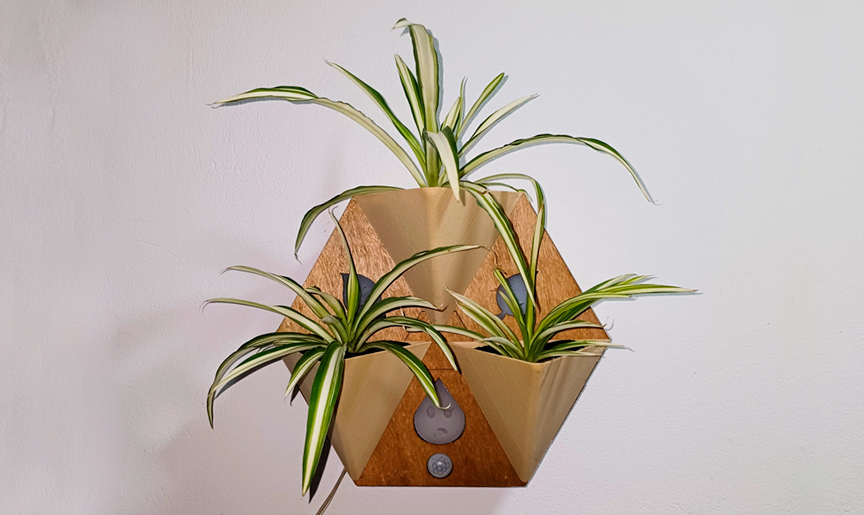
Fab&Plant
What will it do?
Fab&Plant is an interactive living frame designed to reconnect urban dwellers with nature. This innovative green artwork senses your presence, lights up icons to indicate watering needs, and moves in gratitude when plants are well-cared for. Its efficient water use and modular design make it both eco-friendly and versatile, enhancing a living space with vibrant, responsive greenery.
Ecological impact: Fab&Plant is not merely a decoration; it is an ecological statement. In a world racing against time to combat climate change, my project offers the possibility of having plants in small places. It can be hung on walls or placed on horizontal surfaces, providing a solution to the scarcity of green areas.
Interactive experience: But here is what sets Fab&Plant apart -it is not just a static green frame- it is an interactive masterpiece. As you approach, the frame senses your presence and comes alive with lights and movement.
User-Friendly Experience: Plant care can be challenging for citizens living in congested and noisy cities. Daily tasks often distract from the care and enjoyment of having plants at home. Fab&Plant uses fun, illuminated icons to communicate the plants' watering needs when the system detects the user's presence. When the plants need water, a thirsty drop icon lights up. When you manually irrigate the plants, two happy leaf icons light up, and you will see the gentle movement of the plants as a thank you.
Fab&Plant is not just a product; it is a lifestyle. It is a step towards harmonizing urban living with nature. Join us in making cities greener, more interactive, and delightfully sustainable. Let's redefine urban living with Fab&Plant, the interactive living frame.
Who has done what beforehand?
For inspiration and guidance, I reviewed Fab Academy final projects from the past few years.
2023
| Author | Project title | Project video |
|---|---|---|
| Daniel Collins | Moss Wheel | Link |
| Sibin K S | Gropod | Link |
| Ekaterina Kormilitsyna | Symbiotic Devices | Link |
| Ryan Kim | Rotary Hydroponics Garden | Link |
| Lisa Schilling | Selfwatering Flowerpot | Link |
2022
| Author | Project title | Project video |
|---|---|---|
| Pablo Pastor García | Smartpot | Link |
| Paola Zanchetta Muñoz | Fab, Meditation and Plants | Link |
| Juan Carlos Cristaldo | Shadowhouse | Link |
| Rachelle DeCoste | Demeter`s Garden | Link |
| Lakshmi | Selfwatering Pot | Link |
| John Story | Growing Microgreens | Link |
2021
| Author | Project title | Project video |
|---|---|---|
| Ismael Larrea Bravo | Seedling Nursery | Link |
| Jeffery Naranjo | Sustainable Bus Stop | Link |
2019
| Author | Project title | Project video |
|---|---|---|
| Nagi Abdelnour | Automated Indoor Hanging Garden | Link |
These references helped me understand the objective of the final project, guided me to solutions that could be used to solve similar conditions in my project, and inspired me to develop my final project.
What will be designed?
Frame: The case for holding everything together is created using 2D and 3D design, as well as additive and subtractive fabrication processes.
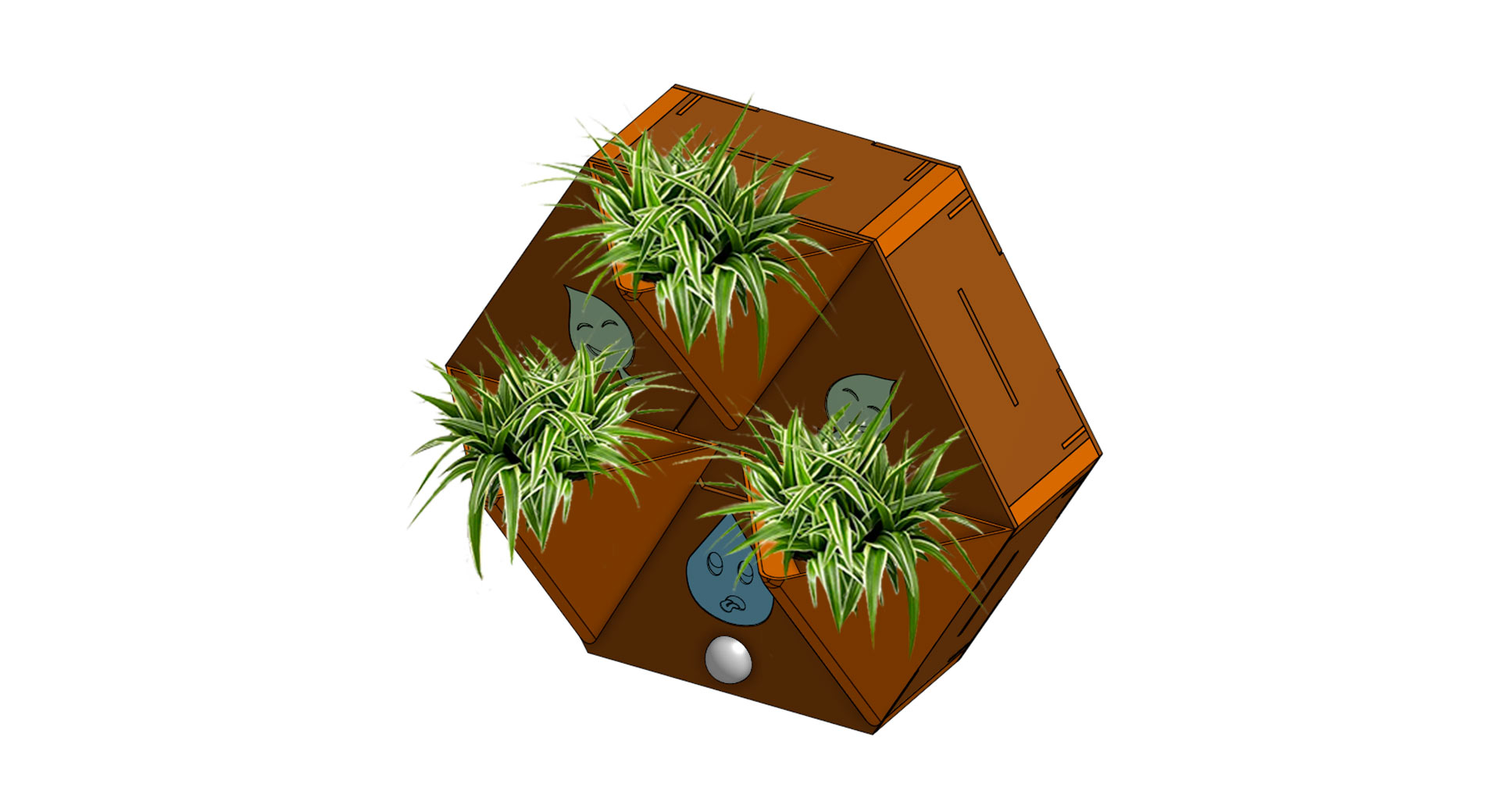
Fab&Plant
Electronics: The Fab&Plant PCB for the system to work.
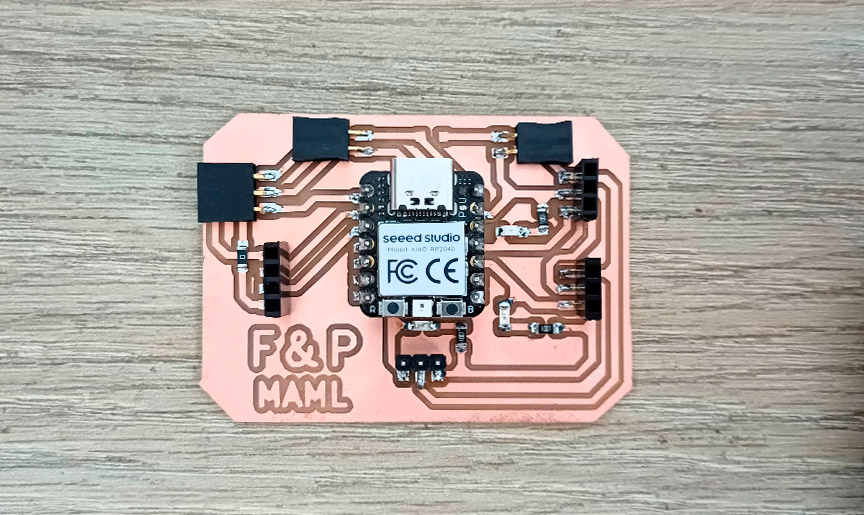
Fab&Plant PCB
Programming: Programming the XIAO RP2040 in Fab&Plant PCB.
//Fab Academy 2024 - Fab Lab Peru - Maria Angela Mejia
//Code for Fab&Plant PCB with a XIAO RP2040
#include < Servo.h>
#define HUMIDITY_SENSOR A0
#define PIR_SENSOR D1
#define BLUE_LED D9
#define GREEN_LED D10
#define SERVO_PIN A3
Servo servoMotor;
void setup() {
pinMode(HUMIDITY_SENSOR, INPUT);
pinMode(PIR_SENSOR, INPUT);
pinMode(BLUE_LED, OUTPUT);
pinMode(GREEN_LED, OUTPUT);
servoMotor.attach(SERVO_PIN);
//LED strips are initially turned off
digitalWrite(BLUE_LED, HIGH);
digitalWrite(GREEN_LED, HIGH);
}
void loop() {
// Read sensors
int humidityValue = analogRead(HUMIDITY_SENSOR);
int pirState = digitalRead(PIR_SENSOR);
// Map humidity value to percentage
int humidityPercentage = map(humidityValue, 1023, 0, 0, 100);
// If humidity is less than 40% and motion is detected, turn on blue LED
if (humidityPercentage < 40 && pirState == HIGH) {
digitalWrite(BLUE_LED, LOW);
digitalWrite(GREEN_LED, HIGH);
// Ensure servo motor is off
servoMotor.write(0);
}
// If humidity is 40% or higher and motion is detected, turn on green LED
else if (humidityPercentage >= 40 && pirState == HIGH) {
digitalWrite(BLUE_LED, HIGH);
digitalWrite(GREEN_LED, LOW);
// Rotate servo motor if humidity is 40% or higher
servoMotor.write(0); // Move the servo to 0 degrees
delay(1000); // Wait for 1 second
servoMotor.write(90); // Move the servo to 90 degrees
delay(1000); // Wait for 1 second
servoMotor.write(180); // Move the servo to 180 degrees
delay(1000); // Wait for 1 second
servoMotor.write(90); // Move the servo back to 90 degrees
delay(1000); // Wait for 1 second
}
// If no motion is detected, turn off both LEDs and servo motor
else {
digitalWrite(BLUE_LED, HIGH);
digitalWrite(GREEN_LED, HIGH);
servoMotor.write(0);
}
}
Fab&Plant PCB code in Arduino IDE
System: The mechanism for cultivating plants and indicating their watering needs.
What materials and components will be used?
Frame:
- Wood PLA filament
- PLA filament
- 3mm plywood
- 4mm cardboard
- Felt fabric
- Silicone rubber
- Screws
- Glue
Electronics:
- XIAO RP2040 (1 unit)
- SMD LED (3 units)
- 0K ohm resistor (2 units)
- 1K ohm resistor (3 units)
- Several pin headers
- Servo motor (1 unit)
- Green LED strip (1 unit)
- Blue LED strip (1 unit)
- PIR sensor (1 unit)
- Water sensor (1 unit)
Where will they come from?
The frame materials came from local suppliers; the Wood PLA filament from SUNLU; electronic items from Paruro Market, and the XIAO RP2040 from Digikey.
How much will they cost?
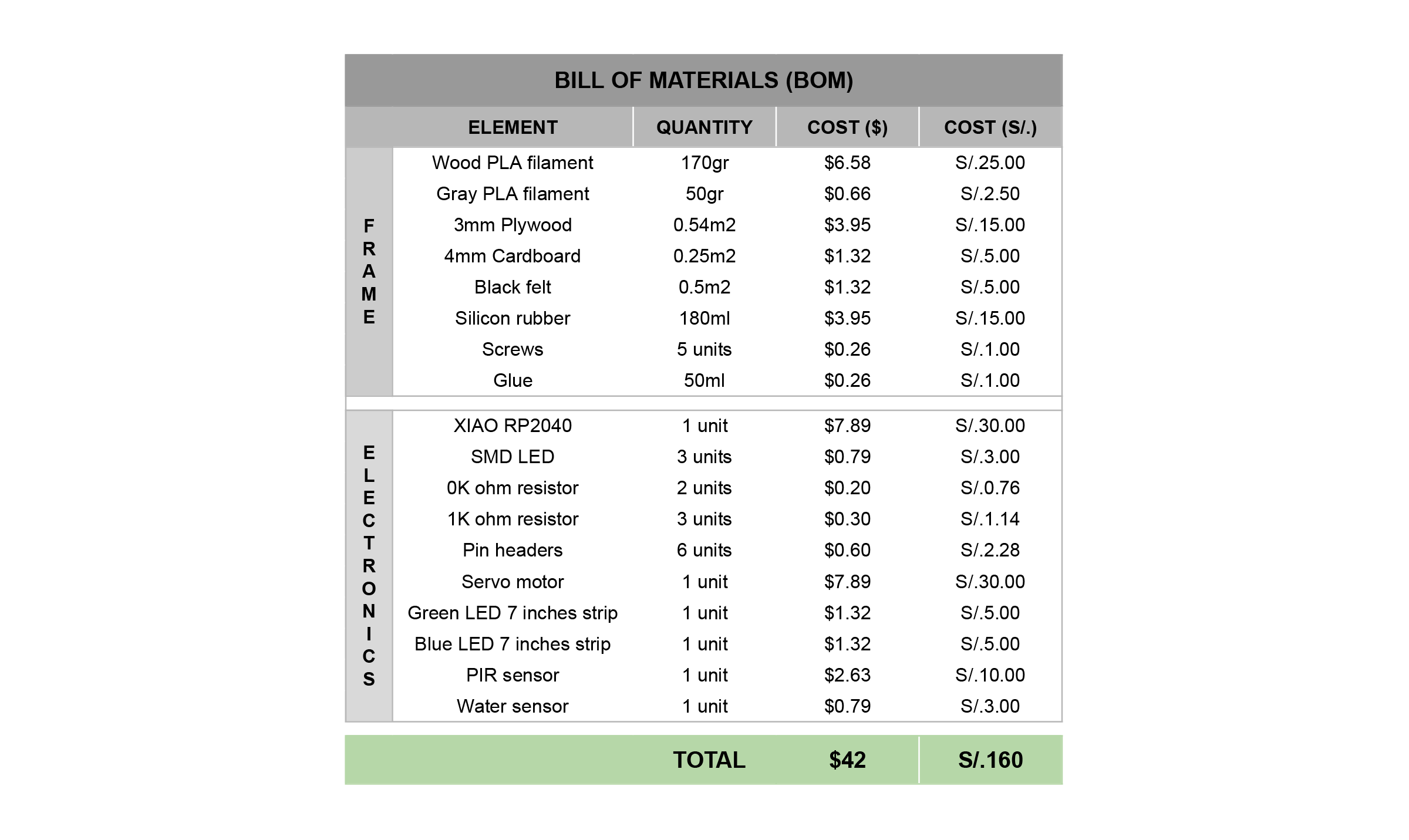
Fab&Plant BOM
What parts and systems will be made?
I made the frame, electronics, programming and the mechanism for cultivating plants and indicating their watering needs.
What processes will be used?
- Computer aided design
- Laser cutting
- 3D printing
- Molding and casting
- Lithophane
- Electronics design
- PCB milling
- Soldering, testing, debugging
- Embedded programming
- Assembly
- Iteration
What questions need to be answered?
- Does Fab&Plant communicate the plants watering need well?
- How long does it take before Fab&Plant needs watering again?
- What is the maximum amount of water the system requires?
How will it be evaluated?
The objective of Fab&Plant is to reconnect ordinary citizens in urban environments with nature. Thanks to its functionality, I believe I have achieved this goal.
Project Development (2/2)
This week, I documented my final project, detailing its purpose, functionality, components, cost, processes involved, and evaluation criteria.
Assignment
- Complete your final project tracking your progress
Learning Outcomes
- Create the project plan
- Track the progress of your project
- Summarise and communicate the essence of your project development
Have you answered these questions?
What tasks have been completed?
I have completed all the necessary tasks to ensure the prototype of my final project works.
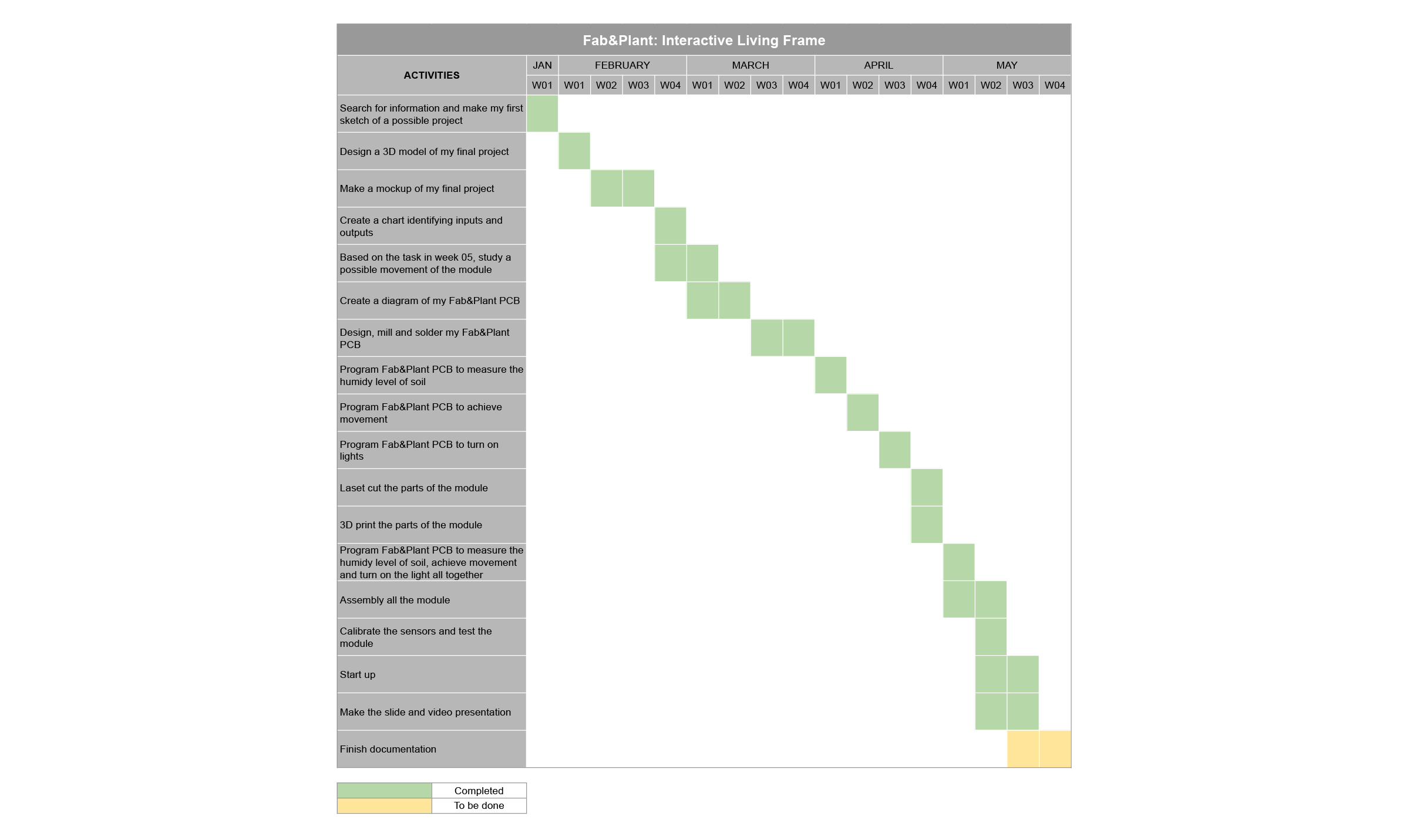
Fab&Plant schedule
What tasks remain?
I must finish the slide and video for my final presentation, in addition to the documentation on my final project page.
What has worked? what hasn't?
In the process of creating this product, the functions I initially envisioned changed. In the end, they all worked, though not in the way I originally imagined.
What I would like to improve is the movement of the pots. Initially, all three pots were supposed to move. I haven't managed to get the top pot to move yet, so I plan to study and test that aspect of my final project more thoroughly.
What questions need to be resolved?
- Does Fab&Plant communicate the plants watering need well?
- How long does it take before Fab&Plant needs watering again?
- What is the maximum amount of water the system requires?
What will happen when?
I hope that by addressing these questions, Fab&Plant will meet all its objectives and become an efficient product.
what have you learned?
Throughout the completion of my final project, I have learned many things, ranging from electronics and programming—which I had never worked on before—to the complexities of manufacturing a product like Fab&Plant. I am very happy with everything I have learned.
Thanks to this week's assignment, I feel that my final project now has greater coherence in different aspects.